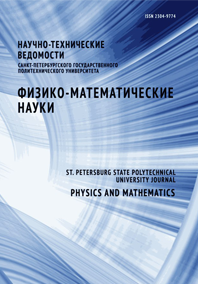Research of temperature dependence of conductivity of arrays of ZnO/Au and ZnO/SnO2 nanorods under the influence of combined visible and ultraviolet irradiation
Arrays of ZnO nanorods of vertical orientation were synthesized by hydrothermal method on quartz substrates. The nanorods had a length of 500‒800 nm and an average cross-sectional size of 40–80 nm. On top of ZnO nanorods, by vacuum thermal evaporation and subsequent annealing at 300 °C, gold (Au) nanoclusters with average sizes of 9 ± 1 nm and 4 ± 0.5 nm and tin oxide (SnO2) nanoclusters with average sizes of 30 ± 5 nm and 15 ± 3 nm. To fabricate resistive sensor elements, V-Ni contact metallization was formed over nanorods by vacuum thermal evaporation. The study of the electrophysical characteristics of arrays of ZnO/Au nanorods showed that the simultaneous effect of temperature and radiation from a LED with a wavelength of 400 nm leads to almost temperature independence of the conductivity of sensor elements.


